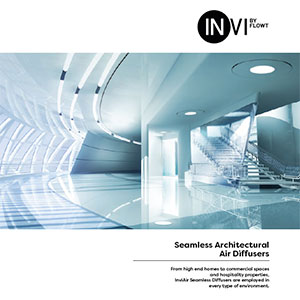The Architect’s Guide to Buying Air Diffusers
Ah, the air diffuser. What was once seen as an unsightly necessity is now being embraced as a fundamental component of a building’s architecture. Choosing the right architectural air diffuser will undoubtedly have a powerful influence on everything from temperature control to noise levels, which warrants a deeper look into its many intricacies.
A common misconception that building product manufacturers have about architects is the notion that they go into a project knowing exactly which products they need based on a set of predetermined standards. The reality is that today’s architectural professionals aren’t afraid of asking questions and testing the waters. New, emerging products in the market aren’t met with hesitation, but rather a sense of curiosity and willingness to experiment. That said, in an era of information overload, it can sometimes be tough for architects to know where to start. Choosing an air diffuser shouldn’t have to be a daunting task. This concise guide is aimed at providing architects with a solid starting point in their research and equipping them with the tools they need to ask the right questions throughout their client’s project journey.
Aesthetics
To start, a key question to ask is: What shape should my client’s air diffuser be? It’s not uncommon for the image of an aluminum square air diffuser with obstrusive detailing to come to mind, as they have been commonplace for years. Chances are that you have seen this type of traditional air diffuser at one point or another; maybe more times than you would have personally liked. It’s hard to get excited about air diffusers when they don’t look particularly appealing in any sense of the word. Thankfully, this is a thing of the past. With so many options on the market today, you shouldn’t have to worry about having to compromise between aesthetics and functionality. There are circle, oval, and linear options that come in a variety of sizes. InviAir has found a way to create a “seamless” air diffuser that blends into architecture, eliminating unsightly edges. Their fully customizable nature even allow for complete control over the shape, size, slot thickness, and slot angle. You can also paint over the air diffuser and add texture to match any unique ceiling types. They even took it a step further and found a way to incorporate LED lighting into their diffusers. This dual-function saves space and eliminates clutter, creating a sleek and streamlined look. So if your client happens to be a veterinary clinic that demands brightly lit paw-prints in their ceilings, you can confidently tell them to consider it done.

Performance
A diffuser is built to serve an array of purposes. It provides the distribution, conditioning, and ventilation of air. At their core, all diffusers should adequately serve two primary functions in order to provide optimal comfort:
- Ensure the even delivery of air flow: When executed properly, diffusers should never cause discomfort to a building’s occupants. The air that’s being produced should feel as though it’s a seamless part of its surrounding environment. A diffuser should never forcefully blow air in a unidirectional manner and doing so should be considered a major red flag. The slot-size and positioning of a diffuser’s vents play an important role in determining the direction of air flow and its distribution.
- Keep noise production at an absolute minimum: No matter the building type, unwanted noises will always be a nuisance to occupants and should be treated with the highest level of consideration. This is especially true for environments that place a premium on noise control, i.e. libraries, bedrooms, and conference rooms. All architects know that they need to perform accurate noise evaluations in their project’s design development process. Diffusers are no exception. A poorly installed diffuser will undoubtedly produce unnecessary levels of noise and vibrations. These vibrations typically occur as sounds collide and clash with the diffuser’s material type. Diffusers made from porous materials have been shown to be the largest contributing factor in dramatically reducing excess noise.
Materials
Choosing the right material is paramount, as it directly impacts an air diffuser’s performance and the many intricacies that accompany it. Manufacturers of air diffusers have relied solely on the use of aluminum and steel as tried and true materials in architectural applications for decades. The advantage of using metal is that it’s fire retardant, sturdy, and resilient. On the flipside, however, are issues of condensation build-up and noise levels. Because aluminum has the tendency to reverberate sounds, the shrill of air is amplified as it passes through the vents. That said, there are new materials being thoroughly tested, iterated upon, and introduced to the market. The introduction of a new smart composite material works to virtually eliminate the aforementioned issues. This alternative to aluminum allows for a porous material that is moisture resistant and quiet, all while retaining the same durable and fire retardant nature of the metal air diffusers. Choosing a composite material over aluminum will drastically reduce unnecessary issues down the road.

Technical Support
It may seem like an afterthought, but the important thing to consider when choosing an air diffuser is the level of support provided by the manufacturer. You’ll want a company that will stick around to help throughout the entire installation process. While shopping around, keep the following things in mind:
- Does the manufacturer orchestrate all communication between the relevant parties (i.e. HVAC, Engineers, and Architects)? Consider the level of involvement that a manufacturer is willing to undertake, as it will likely save you a great deal of time and energy throughout the entire project lifecycle.
- Do they provide clear, detailed instructions on the installation process? Do they offer instructional videos?
- Is there a dedicated phone and/or email support?
- Can they provide swift onsite support if needed?
Lead Time
Although it may vary between manufacturers, the production and delivery of a diffuser is short enough that it shouldn’t directly affect the overall lead time of a project. A diffuser’s turnaround can range from 4-8 weeks, depending on its size and complexity. The location of the design and manufacturing site also plays an integral role in ensuring a timely delivery. When possible, choosing a diffuser that’s manufactured locally will ensure easy communication and a fast turnaround time for your project. What’s more, choosing an agile production team will be beneficial in situations that call for last-minute changes.
So, what’s next?
We hope that this guide has provided you with the essential information needed to take the first step in expanding your air diffuser knowledge and allowing you to make informed decisions down the line. Today, the drastic increase in product innovation is allowing architects to go out and explore their options in an industry that has otherwise remained unchanged for years. By applying better solutions to traditional products, these new and emerging air diffuser manufacturers are giving curious architects the ability to apply new and unique forms of creative expression throughout every project journey.


